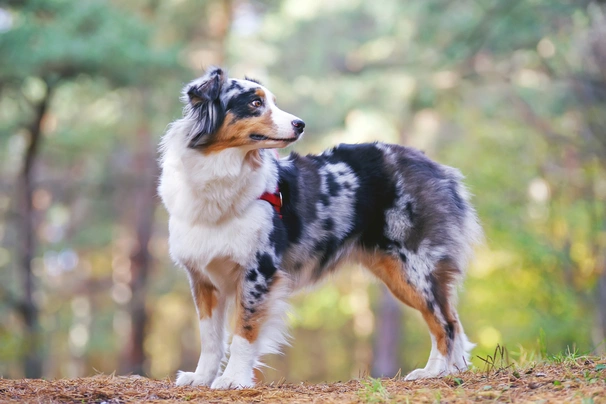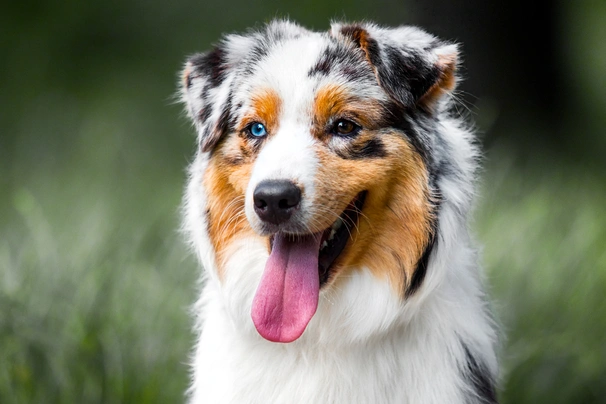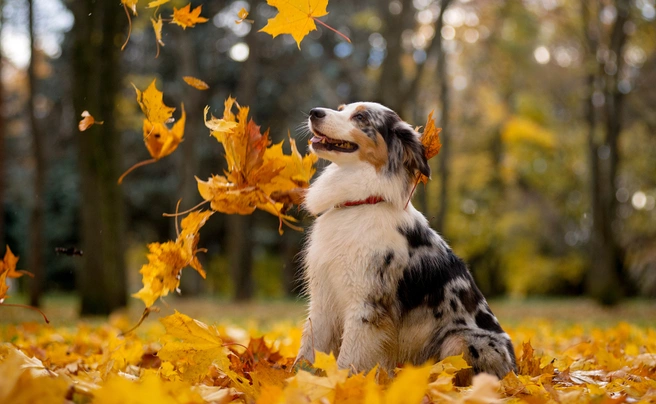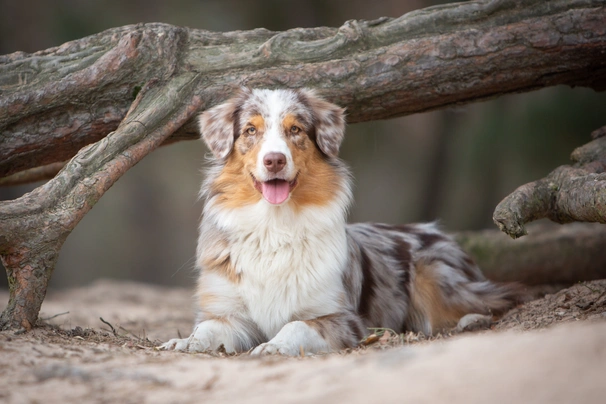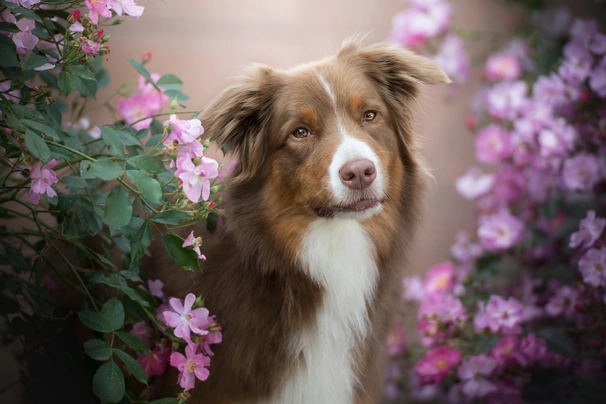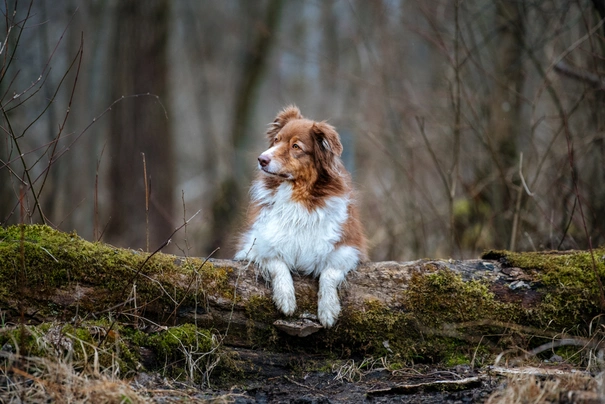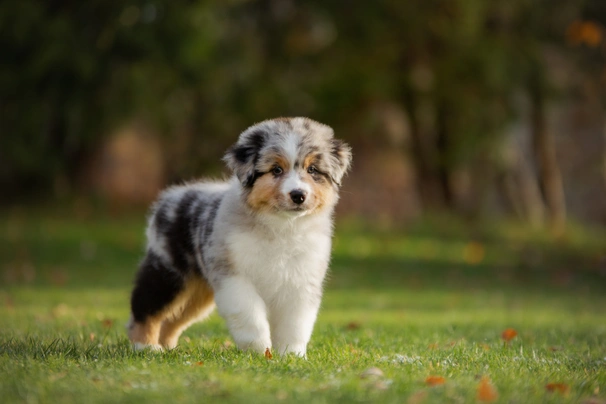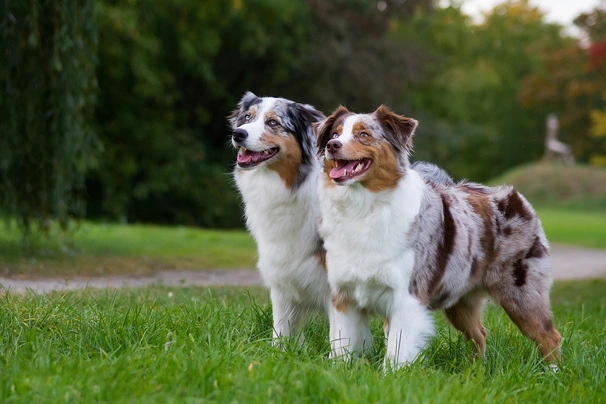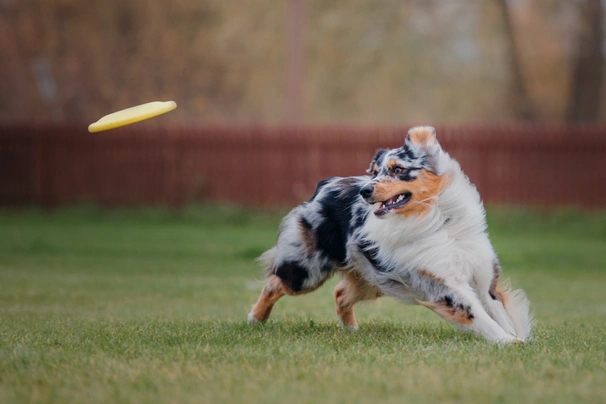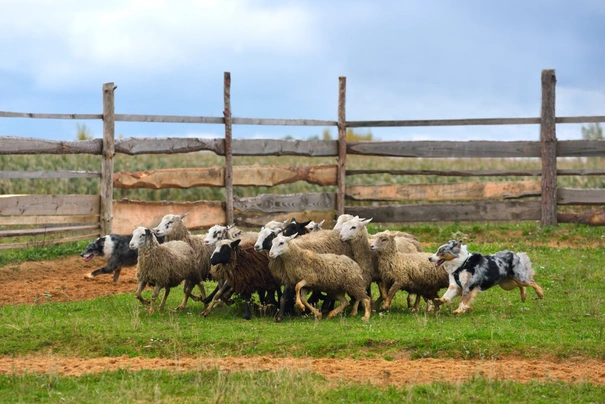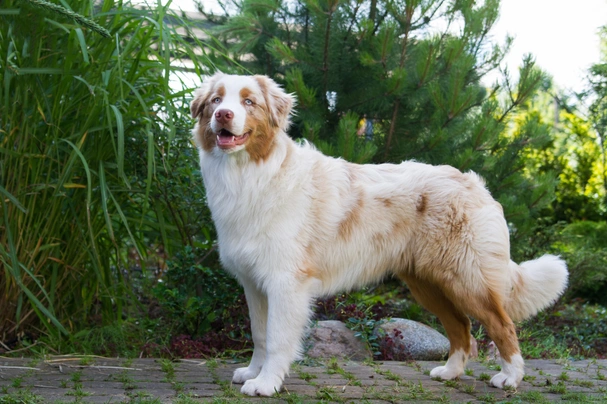Australian Shepherd
Pros
Cons
Introduction of the Australian Shepherd
You'd be forgiven for thinking an Australian Shepherd is native to Australia when in fact the breed hails from the Basque region of Spain. It was from here that these dogs found their way over to America where careful selective breeding produced the dogs we see today. In the States the Aussie or Little Blue Dog as they are often called remains among the most popular choices of working dogs and family pets.
Aussies have also gained popularity as companion dogs and family pets in other parts of the world which is understandable thanks to their intelligence and quick natures. With this said the Aussie is not the best choice for first-time dog owners because they are high-energy characters that need to be correctly trained and then kept busy or they can start to show a more dominant and unruly side of their nature making them harder to manage and handle.
History of the Australian Shepherd
As previously mentioned the Australian Shepherd originates from Spain where they were used as working dogs by Basque shepherds. With this said the breed was mainly developed in the United States. Aussies were first taken over to Australia by shepherds who emigrated there at the end of the nineteenth century. These "blue dogs" were then taken to the Americas where they were given the name Australian Shepherds.
However other people believe that the breed first appeared in the United States when dogs were taken over there by European immigrants. With this said their ancestry is a bit of a mystery but the dogs bought over to Australia from Spain were no doubt crossed with Australian working dogs. At the time they earned themselves the reputation for being devoted dogs that boasted a higher than average intelligence in the working environment and very capable of doing their job without the need for the shepherd to be around.
The breed only arrived in the UK in the mid-1980s when dogs were imported to the country by Mr. & Mrs. Jueckstock and over the years these attractive dogs have gained popularity both as working dogs family pets and companion dogs. Over more recent times they have been trained as Guide Dogs for the Blind Search and Rescue dogs as well as being trained to help handicapped people. A lot of Aussies are used as therapy dogs in nursing homes and hospitals which goes to show just how versatile and intelligent they are.
Interesting facts about the breed
- Is the Australian Shepherd a vulnerable breed? No although they are quite rare in the UK which means puppies can often command a lot of money and anyone wanting to share a home with an Aussie would need to register their interest with breeders for the pleasure of doing so
- An Australian Shepherd's eyes are a beautiful physical feature in the breed and they can be any combination of colours which includes amber pale blue all shades of brown and hazel
- There are 4 basic coat colours in the breed namely black blue merle red and red merle
- Australian Shepherds can have naturally bobbed tails
- Traditionally an Australian Shepherd's tail was always docked but since the law banning the procedure came into effect in 2007 tail docking is now illegal with the exception being for some working breeds and if a dog suffers from some sort of health issue that requires their tails to be docked. The procedure must be agreed and authorised before being performed by a qualified vet but it is worth noting that Australian Shepherds can have naturally bobbed tails
Appearance of the Australian Shepherd
Height at the withers: Males 51 - 58 cm Females 46 - 53 cm
Average weight: Males 23 - 29 kg Females 14 - 20 kg
The Australian Shepherd is a well-proportioned and nicely balanced dog that boasts being slightly longer than they are tall. They are medium in size and well-muscled with a keen and alert look. There is a distinct difference in female and male dogs with both having well defined physical traits.
Their heads are clean cut and well-proportioned in relation to their body. Heads are slightly rounded and boast a well-defined stop. Their eyes are almond shaped brown blue or amber in colour with flecks or marbling in them depending on a dog’s coat colour.
Ears are triangular in shape with slightly rounded tips and set high on a dog's head. Dogs hold their ears either upright or semi-erect and they often drop forwards or to one side when dogs are working or alert. These dogs boast a strong jaw line with a perfect scissor bite where their upper teeth neatly overlap their lower ones. Their necks are moderately long and dogs hold them slightly arched which adds to their proud alert look.
Their forequarters are muscular with long flat well-laid-back shoulder blades and nice strong straight legs. Their body is strong and muscular with a level topline and deep chest. Ribs are well sprung and loins broad and strong looking with a moderately sloping croup.
Their hindquarters are nicely proportioned in relation to their rest of their body and they boast strong looking back legs. Feet are oval in shape and compact with nicely arched toes and well-padded pads. Their tails are moderate in length with a slight amount of feathering. Dogs can be born with a naturally bobbed tail which is allowed as a breed standard.
When it comes to their coat the Australian Shepherd boasts one that is medium in length which can be either slightly wavy or straight. Their coats are extremely weather-resistant all thanks to a dense undercoat. The hair on their head front legs ears and lower legs is short with the back of their legs boasting a moderate amount of feathering. Males have more of a mane than their female counterparts. When it comes to coat colours the accepted colours for Kennel Club registration for the Australian Shepherd are as follows:
- Black
- Black Tricolour
- Black with Copper Trim
- Black with White Trim
- Blue Merle
- Blue Merle White & Copper Trim
- Blue Merle with Copper Trim
- Blue Merle with White
- Red
- Red Merle
- Red Merle White & Copper Trim
- Red Merle with Copper Trim
- Red Merle with White Trim
- Red Tricolour
- Red with Copper Trim
- Red with White Trim
All the above colours can have or not have tan points but any white must not be too dominant a colour on a dog's head. Other areas where white markings are allowed in a dog's coat are as follows:
- On their chest
- On their muzzle
- On a dog’s blaze
- On their underparts
- On their front legs
- On their back legs but not above a dog's hock joint
The 4-basic accepted colours through the Australian Shepherd Breed Club are as follows:
- Black Tri
- Red Tri
- Blue Merle
- Red Merle
Aussies can have or not have white and copper trims in their coats.
Gait/movement
When an Australian Shepherd moves they do so with a smooth free easy and agile gait taking long strides and covering a lot of ground when they do. Dogs keep a nice level topline when they are on the move and their front and back legs remain straight and true.
Faults
The Kennel Club frowns on any exaggerations or departures from the breed standard and would judge the faults on how much they affect a dog's overall health and wellbeing as well as their ability to perform.
Males should have both testicles fully descended into their scrotums and it is worth noting that a dog can be a little lighter or heavier as well as slightly taller or shorter than set out in the Kennel Club breed standard which is only given as a guideline.
Temperament of the Australian Shepherd
The Australian Shepherd is an intelligent dog bred to work and as such their instinct to herd guard and protect remains strong even in a home environment. They boast a tremendous amount of energy and stamina which means they are not the best choice for people who lead more sedentary lives. However for people who spend most of their day outdoors the Australian Shepherd would fit in well with their life style. These are extremely high energy dogs that need to be kept busy or boredom would soon set in which can lead to Aussies developing some serious behavioural issues.
They are known for their loyal and attentive natures and are always ready to turn on a sixpence when they need to which is why they are so highly prized as working and herding dogs. They are also known for their calm and even dispositions although like many other herding dogs the Australian Shepherd can be reserved when they first meet anyone. It takes them a while to get to know strangers which is something that’s very typical of this type of dog.
Their training and socialisation needs to start early in a dog's life for them to grow up to be obedient well-rounded characters. Aussies can be quite demanding which in short means they don't like to be left to their own devices even for short lengths of time. Once they have formed a bond with an owner they will follow them wherever they go and this includes from room to room not liking to be away from the person they have formed a strong bond with.
They are also known to be extremely territorial and will protect things in their environment which can at times get out of control if a dog is not trained correctly from the word go. This is another reason why Aussies are not the best choice for first time owners who may not have enough experience on how to handle and manage these dogs. However for people who are used to handling such intelligent high-energy dogs the Aussie is highly trainable because they thrive on pleasing their owners. These dogs need to know their place in the pack and who is alpha dog in a household.
Aussies excel at all sorts of canine sporting activities which includes things like Flyball trailing and agility all of which are activities they really enjoy taking part in. However thanks to their calm and loyal natures these dogs are often used as assistance dogs for the disabled and are often valued members of search and rescue teams.
Are they a good choice for first time owners?
They are not the best choice for first time dog owners because they need to be socialised handled and trained by people who are familiar with the needs of such an intelligent and high-energy dog. Failing to train an Aussie early enough could result in them being dominant and harder to live with which can make life for owners and their canine companions difficult.
What about prey drive?
The Australian Shepherd was bred to herd large flocks which is a trait that is deeply embedded in a dog's psyche. As such even in a home environment the need to herd remains very strong. With this said they are always quick off the mark to herd anything that moves which can be interrupted as them having a strong prey drive when they meet any other animals which includes smaller pets.
What about playfulness?
Aussies have a very playful and fun-loving side to their natures and like to entertain and be entertained. They are known to be a little mischievous when the mood takes them and being so clever an Aussie quickly learns what pleases an owner and how to get their own way which is one of the reasons they are not a good choice for novice dog owners.
What about adaptability?
An Australian Shepherd is an active energetic dog that needs lots of exercise and mental stimulation. With this said they are not quite as manic as some other collie-type breeds they are better suited to people who have secure well-fenced back gardens a dog can safely roam in whenever possible. In short they are not well suited to living in an apartment.
What about separation anxiety?
Australian Shepherds form strong ties with their families and dogs are never very happy when they find themselves left on their own for longer periods of time. They are better suited to people who either work from home or in households where one person stays at home when everyone else is out so they are never alone for any length of time which could see a dog suffering from separation anxiety. This can lead to them being destructive around the home which is a dog's way of relieving any stress they are feeling and a way to keep themselves entertained.
What about excessive barking?
Some Aussies like the sound of their own voices a little too much which is something that needs to be gently nipped in the bud when a dog is still young being careful not to frighten them. Others will only bark when there are strangers about or when something they don't like is going on in their surroundings or when they want to get an owner's attention.
Do Australian Shepherds like water?
Most Aussies love swimming and will take to the water whenever they can more especially when the weather is hot. However if anyone who owns a dog that does not like water should never force them to go in because it would just end up scaring them. With this said care should always be taken when walking an Aussie off the lead anywhere near more dangerous watercourses just in case a dog decides to leap in and then needs rescuing because they cannot get out of the water on their own. It is also important to thoroughly dry off a dog's coat when they've been swimming because they are so prone to suffering from skin allergies.
Are Australian Shepherds good watchdogs?
Australian Shepherds are not natural watchdogs although this is not to say a dog would not be quick off the mark to let an owner know when there are strangers about although they would rarely do this aggressively. With this said they tend to keep their distance while keeping an eye on things which in short means they are not the best "guard" dogs.
Intelligence / Trainability of the Australian Shepherd
The Australian Shepherd is an intelligent dog but not the best choice for first time owners because they need to be correctly trained and handled from a young age to ensure they know their place in a pack. If Aussies are not given the right sort of direction they can quickly become unruly dominant and hard to manage dogs. An Australian Shepherd needs to find things "challenging" for them to be truly happy in a home environment. It is also worth noting that Aussies often find their own way of doing things which is not always the way an owner wants them to do.
If this happens it's important to seek help because the longer a dog displays this type of behaviour the harder and longer it can be to correct. Enrolling a dog into training class is one solution that tends to work well because there's nothing Aussies like more than when they have something to do. With the right training and handling the Aussie is a wonderful loyal and obedient dog that is a pleasure to be around and own.
Aussie puppies like all puppies are incredibly cute and it is all too easy to spoil them when they first arrive in their new homes. Australian Shepherd puppies are not only very sweet looking but they are extremely smart too and as such they quickly pick new things up which includes the good and the bad. As such as soon as a puppy is settled owners need to start out as they mean to go on which means laying down ground rules and boundaries. This helps an intelligent puppy understand what is expected of them and what is acceptable behaviour and what is not. It also helps establish a pecking order and who is the alpha dog in a household. The first commands a puppy should be taught are as follows:
- Come
- Sit
- Stay
- Heel
- Quiet
- Leave it
- Down
- Bed
Children and other
Aussies although high-energy dogs do make good family pets. However their strong urge to herd anything that moves or which takes their fancy means they can start herding the kids and any other pets that share their environment. With this said it's always a good idea to keep an eye on children and other pets when they are around an Aussie to make sure things stay friendly and calm.
If Aussies grow up with other pets in a household they generally get on well with them and this includes family cats. However when introducing an Australian Shepherd to new pets and other dogs this needs to be slowly and carefully to make sure their first encounter goes smoothly.
Health of the Australian Shepherd
The average life expectancy of an Australian Shepherd Dog is between 13 to 15 years when properly cared for and fed an appropriate good quality diet to suit their ages.
With this said like many other pure breeds the Aussie is known to suffer from certain hereditary health issues which are worth knowing about if you have decided to share your home with one of these high energy intelligent dogs. The health issues most commonly seen in the breed include the following:
- Hip dysplasia - DNA tests available
- Elbow dysplasia - DNA tests available
- Collie Eye Anomaly (CEA) - DNA test available
- Progressive Retinal Atrophy (PRA) - DNA test available
- Pelger Huet Anomaly - Test available
- Cobolamin Malasorption - Test available
- Hereditary Cataracts - dogs should be tested through the Animal Health Trust (AHT)
- Iris Coloboma
- Detached Retina
- Persistent Papillary Membrane (ppm)
- Distichiasis
- Epilepsy
- Multi Drug Resistance (MDR1)
- Cancer - Osteosarcoma mast cell tumours soft tissue carcinoma and leukaemia.
- Allergies
What about vaccinations?
Aussie puppies would have been given their initial vaccinations before being sold but it is up to their new owners to make sure they have their follow-up shots in a timely manner with the vaccination schedule for puppies being as follows:
- 10 -12 weeks old bearing in mind that a puppy would not have full protection straight away but would be fully protected 2 weeks after they have had their second vaccination
There has been a lot of discussion about the need for dogs to have boosters. As such it's best to talk to a vet before making a final decision on whether a dog should continue to have annual vaccinations which are known as boosters.
What about spaying and neutering?
A lot of vets these days recommend waiting until dogs are slightly older before spaying and neutering them which means they are more mature before undergoing the procedures. As such they advise neutering males and spaying females when they are between the ages of 6 to 9 months old and sometimes even when a dog is 12 months old.
Other vets recommend spaying and neutering dogs when they are 6 months old but never any earlier unless for medical reasons. With this said many breeds are different and it is always advisable to discuss things with a vet and then follow their advice on when a dog should be spayed or neutered.
What about obesity problems?
Like other breeds Aussies can gain weight after they have been spayed or neutered and it's important to keep an eye on a dog's waistline just in case they do. If a dog starts to put on weight it's important to adjust their daily calorie intake and to up the amount of exercise they are given. Older dogs too are more prone to gaining weight and again it's essential they be fed and exercised accordingly because obesity can shorten a dog's life by several years. The reason being that it puts a lot of extra strain on a dog's internal organs including the heart which could prove fatal.
What about allergies?
Aussies are prone to suffering from allergies and other skin issues which means it's important for a dog to see a vet sooner rather than later if one flares up. Allergies can be notoriously hard to clear up and finding the triggers can be challenging. With this said a vet would be able to make a dog with an allergy more comfortable while they try to find out the triggers which could include the following:
- Certain dog foods that contain high levels of cereal and other grain-type fillers
- Airborne pollens
- Dust mites
- Environment
- Flea and tick bites
- Chemicals found in everyday household cleaning products
Participating in health schemes
All responsible Australian Shepherd breeders would ensure that their stud dogs are tested for known hereditary and congenital health issues known to affect the breed by using the following schemes:
- BVA/KC Hip Dysplasia Scheme DNA test
- Hereditary cataracts (HC) - HSF4 BVA/KC/ISDS Eye Scheme
- BVA/KC Elbow Dysplasia Scheme DNA test
- Collie eye anomaly (CEA) - CH DNA test
- MDR1 DNA test
- Progressive retinal atrophy prcd-PRA DNA test
- Cobalamin Malabsorption Breed Club
- Blood test for Pelger-Huet Anomaly
All responsible breeders would never breed from a female under 2-years old because they are not ready to have a litter since they are neither mentally or physically ready**.**
What about breed specific breeding restrictions?
The Kennel Club accepts registration of "naturally bobbed tails" because it helps identify which lines carry the gene responsible. A letter from a qualified vet must accompany the request for registration.
The Kennel Club no longer accepts Australian Shepherd puppies whelped from merle parents because of the health risks associated with the merle gene which affects a dog's sight and their vision.
What about Assured Breeder Requirements?
It is mandatory for all KC Assured Breeders to have their dogs tested using the following schemes:
The Kennel Club also strongly recommends that all breeders use the following schemes on stud dogs and puppies:
Caring for the Australian Shepherd
As with any other breed Australian Shepherds need to be groomed on a regular basis to make sure their coats and skin are kept in top condition. They also need to be given regular daily exercise to ensure they remain fit and healthy. On top of this they need to be fed good quality well-balanced diet making sure it is one that meets all their nutritional needs throughout their lives.
Caring for an Australian Shepherd puppy
Aussie puppies are boisterous and full of life which means it's essential for homes and gardens to be puppy-proofed well in advance of their arrival. A responsible breeder would have well socialised their puppies which always leads to more outgoing confident and friendly dogs right from the word go. With this said any puppy is going to feel vulnerable when they leave their mother and littermates which must be taken into account. The longer a puppy can remain with their mother the better although it should never be for too long either.
It's best to pick a puppy up when people are going to be around for the first week or so which is the time needed for a puppy to settle in. Puppy-proofing the home and garden means putting away any tools and other implements that a boisterous puppy might injure themselves on. Electric wires and cables must be put out of their reach because puppies love chewing on things. Toxic plants should be removed from flowerbeds and the home too.
Puppies need to sleep a lot to grow and develop as they should which means setting up a quiet area that's not too out of the way means they can retreat to it when they want to nap and it's important not to disturb them when they are sleeping. It's also a good idea to keep "playtime" nice and calm inside the house and to have a more active "playtime" outside in the garden which means puppies quickly learn to be less boisterous when they are inside.
The documentation a breeder provides for a puppy must have all the details of their worming date and the product used as well as the information relating to their microchip. It is essential for puppies to be wormed again keeping to a schedule which is as follows:
- Puppies should be wormed at 6 months old
- They need to be wormed again when they are 8 months old
- Puppies should be wormed when they are 10 months old
- They need to be wormed when they are 12 months old
Things you'll need for your puppy
There are certain items that new owners need to already have in the home prior to bringing a new puppy home. It's often a good idea to restrict how much space a puppy plays in more especially when you can't keep an eye on what they get up to bearing in mind that puppies are often quite boisterous which means investing in puppy gates or a large enough playpen that allows a puppy the room to express themselves while keeping them safe too. The items needed are therefore as follows:
- Good quality puppy or baby gates to fit on doors
- A good well-made playpen that's large enough for a puppy to play in so they can really express themselves as puppies like to do
- Lots of well-made toys which must include good quality chews suitable for puppies to gnaw on bearing in mind that a puppy will start teething anything from when they are 3 to 8 months old
- Good quality feed and water bowls which ideally should be ceramic rather than plastic or metal
- A grooming glove
- A slicker brush or soft bristle brush
- Dog specific toothpaste and a toothbrush
- Scissors with rounded ends
- Nail clippers
- Puppy shampoo and conditioner which must be specifically formulated for use on dogs
- A well-made dog collar or harness
- A couple of strong dog leads
- A well-made dog bed that's not too small or too big
- A well-made dog crate for use in the car and in the home that's large enough for a puppy to move around in
- Baby blankets to put in your puppy's crate and in their beds for when they want to nap or go to sleep at night
Keeping the noise down
All puppies are sensitive to noise including Australian Shepherd puppies. It's important to keep the noise levels down when a new puppy arrives in the home. TVs and music should not be played too loud which could end up stressing a small puppy out which could end up making them timid and shy.
Keeping vet appointments
As previously mentioned Aussie puppies would have been given their first vaccinations by the breeders but they must have their follow up shots which is up to their new owners to organise. The vaccination schedule for puppies is as follows:
- 10 -12 weeks old bearing in mind that a puppy would not have full protection straight away but would only be fully protected 2 weeks after they have had their second vaccination
When it comes to boosters it's best to discuss these with a vet because there is a lot of debate about whether a dog really needs them after a certain time. However if a dog ever needed to go into kennels their vaccinations would need to be fully up to date.
What about older Australian Shepherds when they reach their senior years?
Older Aussies need lots of special care because as they reach their golden years they are more at risk of developing certain health concerns. Physically a dog's muzzle may start to go grey but there will be other noticeable changes too which includes the following:
- Coats become coarser
- A loss of muscle tone
- Aussies can either become overweight or underweight
- They have reduced strength and stamina
- Older dogs have difficulty regulating their body temperature
- They often develop arthritis
- Immune systems do not work as efficiently as they once did which means dogs are more susceptible to infections
Older dogs change mentally too which means their response time tends to be slower as such they develop the following:
- They respond less to external stimuli due to impaired vision or hearing
- They tend to be a little pickier about their food
- They have a lower pain threshold
- Become intolerant of any change
- Often an older dog can feel disorientated
Living with an Aussie in their golden years means taking on a few more responsibilities but these are easily managed and should include taking a look at their diet the amount of exercise they are given how often their dog beds need changing and keeping an eye on the condition of their teeth.
Older Australian Shepherds should be fed a good quality diet that meets their needs at this stage of their lives all the while keeping a close eye on a dog's weight. A rough feeding guide for older dogs as follows bearing in mind they should be fed highly digestible food that does not contain any additives:
- Protein content should be anything from 14 – 21%
- Fat content should be less than 10%
- Fibre content should be less than 4%
- Calcium content should be 0.5 – 0.8%
- Phosphorous content should be 0.4 – 0.7%
- Sodium content should be 0.2 – 0.4%
Older Aussies don't need to be given the same amount of daily exercise as a younger dog but they still need the right amount of physical activity to maintain muscle tone and to prevent a dog from putting on too much weight. All dogs need access to fresh clean water and this is especially true of older dogs when they reach their golden years because they are more at risk of developing kidney disorders.
Grooming of the Australian Shepherd
Having moderately long coats the Aussie needs to be groomed at least once a week to prevent any mats and tangles forming and to keep their skin in good condition. Like other dogs they shed more during the Spring and then again in the Autumn when more frequent brushing is usually necessary to keep on top of things.
When it comes to bathing Aussies only need to be bathed a couple of times a year or when it is really necessary. It's important to use a dog specific shampoo or it could trigger a skin allergy flaring up. Over-bathing a dog can have a negative impact on the condition of their skin and coats stripping all the natural oils out which can lead to dry and flaky skin and once this happens it can result in sore developing which make a dog’s life very uncomfortable and it opens the door to an infection flaring up.
Exercise of the Australian Shepherd
Aussies are high energy dogs that need to be given a ton of exercise every day. They also need lots of mental stimulation on a daily basis for them to be truly happy well-rounded characters. The saying a "tired dog is a happy dog" is never truer than when talking about an Australian Shepherd. In short these dogs are never happier than when they are given a "job" to do and would be extremely unhappy dogs if they are left to their own devices for long periods of time.
Australian Shepherds are renowned for their herding abilities and therefore they excel at canine sporting activities like competitive obedience agility and Flyball to name but three. When these dogs are not given the right amount of daily exercise it can result in them becoming destructive around the house and they also turn into nervous characters with some dogs becoming unstable too. The Australian Shepherd is definitely not a good choice for first time owners or for people who lead more sedentary lives for these reasons.
Feeding of the Australian Shepherd
Australian Shepherds are not known to the fussy of finicky eaters. However this does not mean they can be fed a lower quality diet. They are high energy characters that like to be kept busy and as such they really do benefit from being fed a home-made natural diet that contains the right levels of proteins and other valuable nutrients this dog needs to remain healthy.
If you get an Aussie puppy from a breeder they would give you a feeding schedule and it's important to stick to the same routine feeding the same type of puppy food to avoid any tummy upsets. You can change a puppy's diet but this needs to be done very gradually always making sure they don't develop any digestive upsets in the process and if they do it's best to put them back on their original diet and to discuss things with the vet before attempting to change their diet again.
Feeding guide for an Australian Shepherd puppy
Puppies need to be fed a highly nutritious good quality diet for them to develop and grow as they should. As a rough guide an Aussie puppy can be fed the following amounts every day making sure their meals are evenly spread out throughout the day and it's best to feed them 3 or 4 times a day:
- 2 months old - 194g to 258g depending on puppy's build
- 3 months old - 236g to 312g depending on puppy's build
- 4 months old - 255g to 338g depending on puppy's build
- 5 months old - 261g to 359g depending on puppy's build
- 6 months old - 271g to 371g depending on puppy's build
- 8 months old - 234g to 335g depending on puppy's build
- 10 months old - 192g to 246g depending on puppy's build
Once a puppy is 12 months old they can be fed adult dog food.
Feeding guide for an adult Australian Shepherd
Once fully mature an adult Australian Shepherd must be fed a good quality diet to ensure their continued good health. As a rough guide an adult Aussie can be fed the following amounts every day:
- Dogs weighing 14 kg can be fed 195g to 263g depending on activity
- Dogs weighing 20 kg can be fed 233g to 307g depending on activity
- Dogs weighing 23 kg can be fed 275g to 362g depending on activity
- Dogs weighing 29 kg can be fed 295g to 382g depending on activity
Australian Shepherd price
If you are looking to buy an Australian Shepherd Dog you would need to be prepared to pay anything from £500 to over £900 for a well-bred pedigree puppy. The cost of insuring a male 3-year-old Australian Shepherd Dog in northern England would be £22.51 a month for basic cover but for a lifetime policy this would set you back £42.97 a month (quote as of February 2018). When insurance companies calculate pet insurance they factor in a few things and this includes where you live in the UK whether a dog is neutered or spayed a dog's age and their breed.
When it comes to food costs you need to buy the best quality food whether wet or dry to feed your dog throughout their lives making sure it suits the different stages of their lives. This would set you back between £40 - £60 a month. On top of this you would need to factor in veterinary costs if you want to share your home with an Aussie and this includes their initial vaccinations their boosters the cost of neutering or spaying your dog when the time is right and their annual health check visits all of which could quickly add up to well over a £1000 a year.
As a rough guide the average cost to keep and care for an Australian Shepherd would be between £90 to £120 a month depending on the level of insurance cover you opt to buy for your dog but this does not include the initial cost of buying a healthy well-bred Kennel Club registered pedigree Australian Shepherd puppy.
Buying advice
When visiting and buying any puppy or dog there are many important things to consider and questions to ask of the breeder/seller. You can read our generic puppy/dog advice here which includes making sure you see the puppy with its mother and to verify that the dog has been wormed and microchipped.
Australian Shepherds are becoming a popular breed both in the UK and elsewhere in the world which means that well-bred puppies can often command a lot of money. As such with Australian Shepherds there is specific advice questions and protocols to follow when buying a puppy which are as follows:
- Beware of online scams and how to avoid them. You may see online and other adverts by scammers showing images of beautiful Australian Shepherdpuppies for sale at very low prices. However the sellers ask buyers for money up front before agreeing to deliver a puppy to a new home. Potential buyers should never buy a puppy unseen and should never pay a deposit or any other money online to a seller. You should always visit the pet at the sellers home to confirm they are genuine and make a note of their address.
- As previously touched upon Australian Shepherds have gained a large fanbase in the UK and are now a popular breed. As such there are many amateur breeders/people who breed from a dam far too often so they can make a quick profit without caring for the welfare of the puppies their dam or the breed in general. Under Kennel Club rules a dam can only produce 4 litters and she must be between a certain age to do so. Anyone wishing to buy an Australian Shepherd puppy should think very carefully about who they purchase their puppy from and should always ask to see the relevant paperwork pertaining to a puppy's lineage their vaccinations and their microchipping.
- Prospective owners should be aware that all responsible breeders would never breed from a female under 2-years old because they are not ready to have a litter since they are neither mentally or physically ready.
- Traditionally an Australian Shepherd's tail was always docked but since the law banning the procedure came into effect in 2007 tail docking is now illegal with the exception being for some working breeds and if a dog suffers from some sort of health issue that requires their tails to be docked. The procedure must be agreed and authorised before being performed by a qualified vet but it is worth noting that Australian Shepherds can have naturally bobbed tails.

Beautiful home bred
£1,800
Show quality Australian Shepherd puppiesies
£1,500
